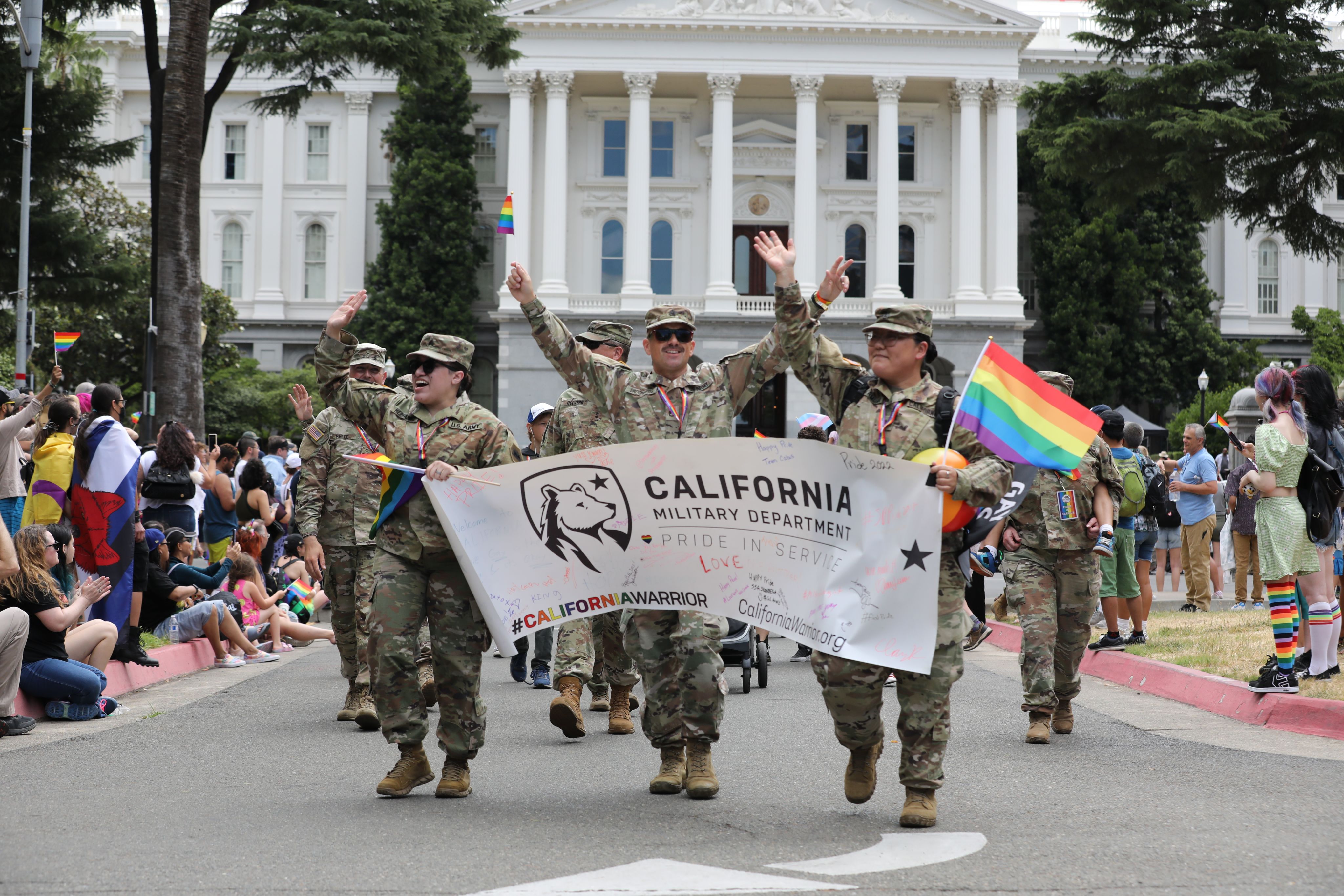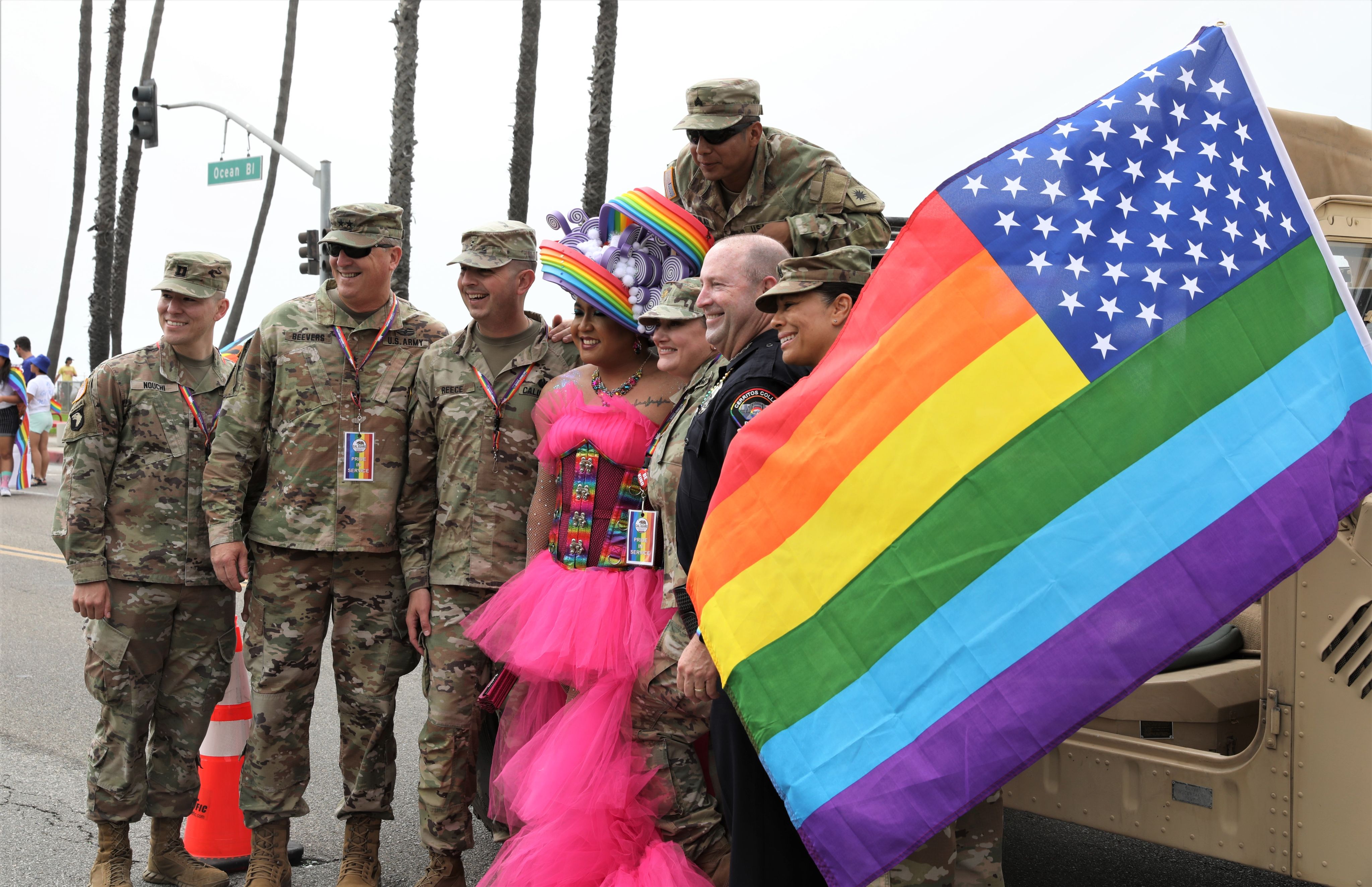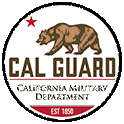Honoring service across the Rainbow
Cal Guard marches with Pride across the state

Story by Amanda H. Johnson
Video and photos by 69th Public Affairs Detachment
California National Guard
August 10, 2022
SAN DIEGO – The sharp rapping sound of snare drums echoes between buildings as hundreds of people weave around three U.S. Marine musicians in Dress Blues, warming up for their performance in the San Diego Pride Parade, July 16, 2022.
A roar from the crowd is heard in the distance, and the drummers hurriedly take their place at the rear of the Marine Corps Band Sand Diego formation, awaiting their signal to follow the cluster of U.S. Armed Forces flags.
The seven-member color guard march in-step with a slight breeze billowing the thick fabric of the standards as the teeming sidewalks cheer for the military’s representation. They lead the procession of military banners, uniformed service members, and veterans from every branch of service proudly waving rainbow streamers.
A tan Humvee surrounded by California National Guardsmen with the acting Adjutant General, U.S. Army Maj. Gen. Matthew P. Beevers, waves to the horde of fans as shouts of appreciation are heard to the entire group of military troops.
“We received so much love and support from the spectators, random hugs and high fives paired with “Thank you for your service,” said California State Guard Chief Warrant Officer 2 Matthew Reece, deputy director at Discovery ChalleNGe Academy. “It’s enough to make you really proud of who you are and the organization you serve.”
Cal Guard has a long-standing tradition with Pride, going back several years.
“We’ve had a very long-term relationship with the California National Guard,” said Clay Kilpatrick, Chair of the San Diego Pride Military Department. “They have participated for 8 or 9 years now, and we’re always honored to have them participate; we are proud they are with us and choose to be here.”
Cal Guard troops have volunteered to participate in several Pride parades that have taken place over the past two months in Sacramento, Long Beach, and San Diego.
CNG’s participation in multiple locations enabled troops to participate in an event close to them, and engaged more communities, said Reece.
“I can recall two young California Air Guard members who were in disbelief they could march in uniform and were ecstatic that we were at a pride event near their home station,” said Reece.
After almost two years of COVID-19 restrictions, Californians were back out in force with support for parade participants and to join the joyful celebrations honoring the diversity of the state.
Lesbian, Gay, Bisexual, Transgender and Queer Pride Month is celebrated every year in June to honor the 1969 Stonewall Uprising in Manhattan. The civil disturbance in New York was the tipping point for the Gay Liberation Movement in the U.S., according to the Library of Congress.
In major cities across the nation, a month-long series of commemorations are hosted through parades, picnics, parties, symposiums, and concerts that attract millions of participants.
The purpose of Pride is to recognize the impact that LGBTQ+ individuals have had on history; locally, nationally, and internationally.
For the military and veteran communities, their recognized participation hits a little stronger than most.



“Throughout American history, LGBTQ+ citizens have fought to defend our rights and freedoms -- from the Founding of our nation to the Civil War, from the trenches of two World Wars to Korea and Vietnam, and from Afghanistan to Iraq,” said Secretary of Defense Lloyd J. Austin III, in his speech at the Pentagon, June 9, 2021.
“They fought for our country even when our country wouldn’t fight for them. Even as some were forced to hide who they were… or to hang up their uniforms.”
Austin referred to the long history of LGBTQ+ service members who served without disclosing their sexuality, being medically declared unfit, criminalized, or dishonorably discharged if their sexuality was found out.
DoD’s Office of Diversity Management and Equal Opportunity highlighted many events that took place in the history of LGBTQ+ fight for rights.
In the 1940s, Homosexuality and diverse gender identities were socially, culturally, and medically classified as mental illnesses, disqualifying openly LGBTQ+ individuals from service.
By 1981, DoD published directive 1332.14, which established a policy of mandatory discharge for service members who had engaged in “homosexual acts.”
Between 1980-1990, an average of 1,500 service members were discharged annually.
In 1993, President Bill Clinton signed into law “Don’t Ask, Don’t Tell (DADT),” the first attempt at a compromise for LGBTQ+ service members.
“I was actually in the service before Don’t Ask, Don’t Tell was implemented,” said Kilpatrick, who served in the U.S. Marine Corps for eight years. “I got out because I didn’t want to lose my career if someone found out I was gay.”
DADT allowed LGBTQ+ people to serve in the military, but only if they did not disclose their sexual orientation. Service members would not be asked about their sexual orientation but would be discharged for disclosing it.
DADT was supposed to assist troops, but it made things worse for LGBTQ+ service members, said Kilpatrick.
Between 2010-11, President Obama signed legislation repealing DADT. Upon the implementation of the repeal act, service members were allowed to serve openly for the first time.
“It’s so critical to now see for the last 11 years my military members wearing their uniforms and living their true authentic selves,” said Kilpatrick. “Not only for themselves, but when people see them in uniform and know they are part of the community or support LGBTQ members, it’s harder for them to discriminate and take our rights away.”
Since the repeal of DADT, LGBTQ+ service members have also won the right for same-sex marriage, and equal military benefits for their spouses and family. Supporting the uniformed service member is an important part of the California Military Department and all who serve the state and nation, said Beevers.
“I was pleasantly surprised at the number of allies marching with us, including Maj. Gen. Beevers,” said Reece. “It shows the values of the organization and its leadership.”



From the national spotlight to the local scene, LGBTQ+ rights are a topic of consternation. Though milestones have been achieved in support for equal rights and protection from discrimination, there are still groups threatening this progress.
“At the end of the day, it doesn’t matter who you love,” said Beevers. “It only matters if you can fight.”
“At the end of the day, it doesn’t matter who you love. It only matters if you can fight."
1940s
Homosexuality and diverse gender identities were socially, culturally, and medically classified as mental illnesses, disqualifying openly LGBTQ+ individuals from service.
1969
The Stonewall riots take place at the Stonewall Inn in the Greenwich Village neighborhood of Manhattan, New York City. These demonstrations are in response to policy discrimination of LGBTQ+ individuals and were a catalyst for the Gay liberation movement in the U.S.
1981
DoD Directive 1332.14 establishes a policy of mandatory discharge for service members who have engaged in "homosexual acts."
Between 1980-1990, an average of 1,500 military service members are discharged annually on the basis of sexual orientation.
1993
President Bill Clinton signs into law "Don't Ask, Don't Tell."
2010-2011
President Obama signs legislation repealing DADT. Once the repeal act was fully implemented, LGBTQ+ service members were allowed to serve openly.
"Throughout American history, LGBTQ+ citizens have fought to defend our rights and freedoms -- from the Founding of our nation to the Civil War, from the trenches of two World Wars to Korea and Vietnam, and from Afghanistan to Iraq.
They fought for our country even when our country wouldn’t fight for them.
Even as some were forced to hide who they were… or to hang up their uniforms."
Secretary of Defense Lloyd J. Austin III











California State Guard Staff Sgt. Stephne Nakamura waves a pride flag in Sacramento's Pride parade, June 12. (U.S. Army National Guard Photo by Pfc. William Franco Espinosa)
California State Guard Staff Sgt. Stephne Nakamura waves a pride flag in Sacramento's Pride parade, June 12. (U.S. Army National Guard Photo by Pfc. William Franco Espinosa)










